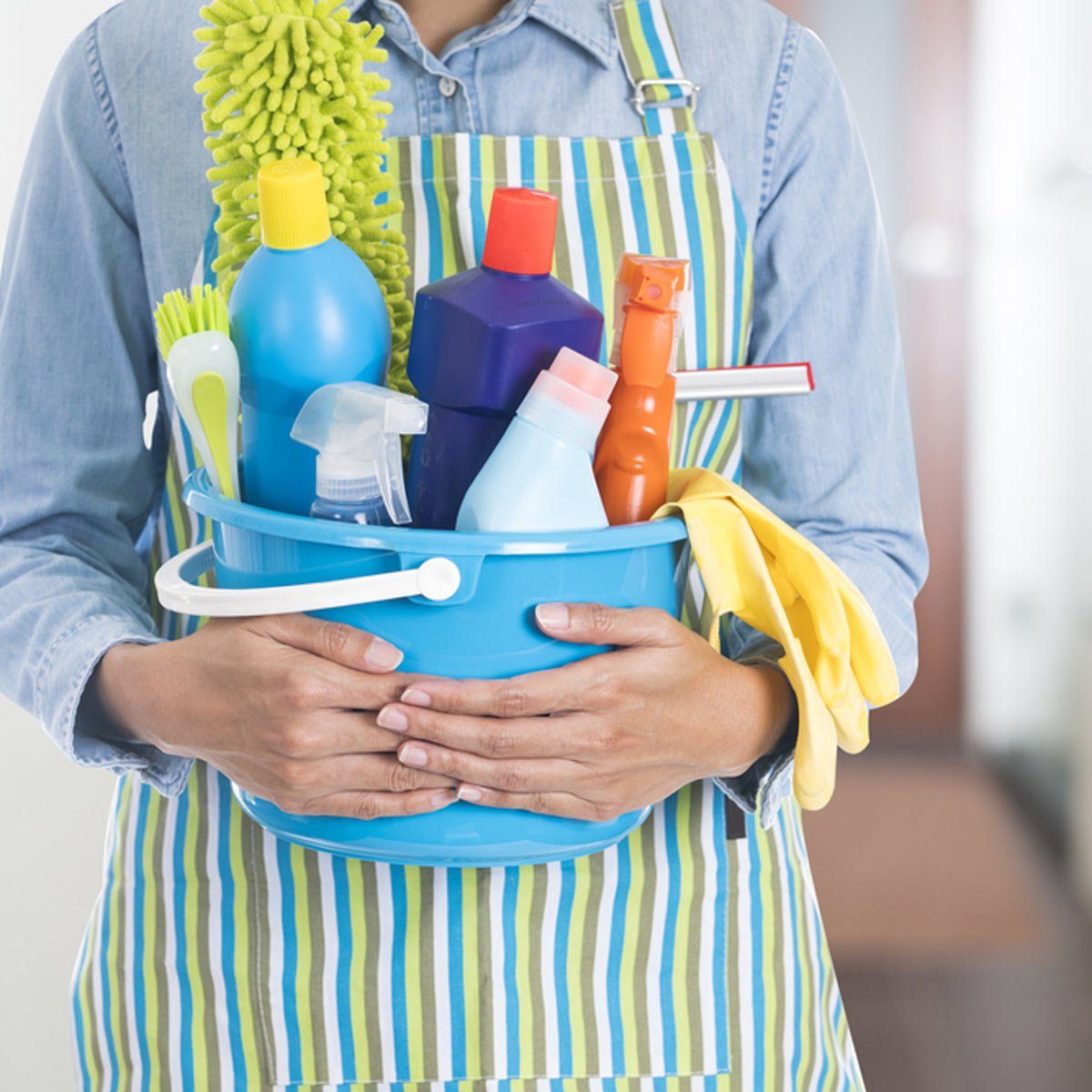
Bleach is Best
Though most people associate the smell of bleach with clean, this cleaning myth just isn’t the case. In fact, bleach doesn’t really even clean at all. It disinfects, kills germs and can whiten stains, but it doesn’t clean dirt and grime from surfaces. So if you’re looking to whiten your shirt or rinse away bacteria from that raw chicken in your sink, then bleach is your way to go. However, if you’re trying to remove the grit from your bathtub, you’ll need an actual cleaning product, preferably something with some texture, like baking soda. Bleach definitely has its benefits. Try these 10 ways you’re not using bleach but should be.

Newspaper Will Give You Streak-Free Glass
You’ve probably seen your grandparents use newspapers to clean mirrors and glass and wondered if what if this cleaning myth actually works. Well, yes and no. Yes, because newspaper at one time was made of out papers and ink that did indeed leave mirrors and glasses streak-free. Sadly, newspaper today is made out of different materials than way back then and can actually leave streaks on your mirrors. Trying using rubbing alcohol or a glass cleaner with a microfiber cloth.

Feather Dusters Dust
Sure, they’re soft and fluffy, but contrary to their name, feather dusters, don’t really do much of dusting. More often than not, they just spread the dust around. Instead, reach for a vacuum with a nozzle attachment or a soft damped cloth when trying to get rid of dust. More than 90 percent of household dust comes from tiny flakes of skin and barely visible fabric fibers that float on the slightest air current and settle on every surface in your house. It’s one of the cleaning mistakes that will make your home dirtier.

Fragrant Scents = Clean
You might think that if something that smells fresh and good, it’s clean, but don’t let your nose fall for this cleaning myth. Just because a product is labeled as “fresh laundry” or “clean spring air” doesn’t mean that it actually removes dirt and germs. While those air freshener sprays do smell wonderful, they don’t do a thing when it comes to actually removing dirt, stains and germs. In fact, they don’t really even freshen a room, more so just make it smell a bit better for the time being. Here are 21 clever ways to make your home smell amazing.

Polish Wood Weekly
While gleaming floors and furniture are coveted, you should, in fact, polish them sparingly. In fact, most wooden furniture sold on the market today doesn’t need to be polished at all. Applying too much polish and/or wax will lead to build up and actually make your furniture appear more dull. If you notice dust or other debris, regular water on a cloth will do the trick.

Vinegar Cleans All
Vinegar is such a fabulous cleaner that it’s easy to go vinegar crazy (all-natural and inexpensive!). With so many different uses around the house, this trusted item—in its white vinegar as well as its apple cider vinegar versions—deserves a special place in your pantry. Unfortunately, this staple kitchen product shouldn’t be used to clean everything you own. While vinegar does a great job on walls, bathrooms, dishes and as a fabric softener, it should never be used to clean hardwood, marble, stone finishes or wax floorings, as the vinegar may actually cause dulling.

Hairspray Removes Ink Stains
Hairspray, like newspaper being used to clean mirrors, has been used as a stain remover for many, many years. Unfortunately, also like newspaper, the formula to hairspray has changed over time—and while alcohol-free versions are better for your hair—it’s not as good at removing stains as it once was. So next time you spill red wine all over your white dress, reach for an actual stain remover, or opt for a homemade version using vinegar or hydrogen peroxide.

Wash All Clothes in Cold Water
Doing your laundry is a tad more complicated than just pressing a button on the washer machine. Many find it frustrating trying to decode which color is washed for how long and in what temperature, which is probably why most people wash everything on cold (and it’s also a money-saver). Most pieces can be washed in cold water—especially dark and bright colors or delicate fabrics—as the colder temperature works wonders in removing stains and ensuring clothes don’t shrink, but some things like whites should be washed on hot, and man-made fibers, knits and jeans should be washed on warm. Find out the other laundry mistakes you are probably making.

Cleaning Solutions Act Instantly
You can’t expect to spray a product and instantaneously have a perfectly clean, spotless surface. That’s called magic, and there’s a debate on whether it even exists. After applying a cleaning solution, let it soak in for the allotted time, and be patient. Wiping it off too early will likely result in dirt and germs remaining, as well as a huge waste of product. And, you need to add in a bit of elbow grease, too. While that kitchen cleaner is great for breaking up grease on the stove, it’s not going to remove itself. You’ll need to scrub it with a sponge or rag—and a lot of pressure. If you’re into DIYing all-natural cleaning solutions, these homemade cleaners really work.

Use a Specialized Grout Cleaner
Harsh chemicals may make grout even more difficult to clean. Instead, try mixing equal parts white vinegar with water in a spray bottle. Spray the area generously and let it sit for five minutes. Then make a paste with baking soda and water and use a grout brush or toothbrush to clean the grout. Then rinse with water. This is the best all-purpose cleaner you can buy.
The post 10 Cleaning Myths You Need to Stop Believing—and What to Do Instead appeared first on Taste of Home.
Kaitlyn Chamberlin